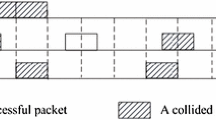Abstract
In the study of multiple-access in the collision channel, conflict-avoiding code is used to guarantee that each transmitting user can send at least one packet successfully in the worst case within a fixed period of time, provided that at most k users out of M potential users are active simultaneously. The number of codewords in a conflict-avoiding code determines the number of potential users that can be supported in a system. Previously, upper bound on the size of conflict-avoiding code is known only for Hamming weights three, four and five. The asymptotic upper in this paper extends the known results to all Hamming weights, and is proved to be tight by exhibiting infinite sequences of conflict-avoiding codes which meet this bound asymptotically for all Hamming weights.
Similar content being viewed by others
References
Chen C.S., Wong W.S., Song Y.Q. (2008) Constructions of robust protocol sequences for wireless sensor and ad hoc networks. IEEE Trans. Veh. Tech. 57(5): 3053–3063
da Rocha V.C. Jr. (2000) Protocol sequences for collision channel without feedback. IEE Electron. Lett. 36(24): 2010–2012
Györfi L., Vajda I. (1993) Construction of protocol sequences for multiple-access collision channel without feedback. IEEE Trans. Inform. Theory 39(5): 1762–1765
Hardy G.H. (1999) Ramanujan: Twelve Lectures on Subjects Suggested by His Life and Work, 3rd edn. Chelsea, New York
Hecke E. (1981) Lectures on the Theory of Algebraic Numbers. No. 77 in Graduate Texts in Math. Springer-Verlag, New York
Ireland K., Rosen M. (1990) A Classical Introduction to Modern Number Theory. Springer-Verlag, New York
Jimbo M., Mishima M., Janiszewski S., Teymorian A.Y., Tonchev V.D. (2007) On conflict-avoiding codes of length n = 4m for three active users. IEEE Trans. Inform. Theory 53(8): 2732–2742
Kneser M. (1953) Abschätzungen der asymptotischen dichte von summenmengen. Math. Zeit. 58: 459–484
Levenshtein V.I.: Conflict-avoiding codes with multiple active users. In: Proc. 14th Int. Conf. on Probl. Theor. Cybern., Moscow (2005), p. 86.
Levenshtein V.I. (2007) Conflict-avoiding codes for three active users and cyclic triple systems. Probl. Inform. Transm. 43(3): 199–212
Levenshtein V.I., Han Vinck A.J. (1993) Perfect (d,k)-codes capable of correcting single peak-shift. IEEE Trans. Inform. Theory 39(2): 656–662
Mann H.B. (1965) Addition Theorems: The Addition Theorems of Group Theory and Number Theory. No. 18 in Interscience Tracks in Pure and Appl. Math. Interscience Publisher, New York
Massey J.L., Mathys P. (1985) The collision channel without feedback. IEEE Trans. Inform. Theory 31(2): 192–204
Mathys P. (1990) A class of codes for a T-active-users-out-of-N multiple-access communication system. IEEE Trans. Inform. Theory 36(6): 1206–1219
Mishima M., Fu H.L., Uruno S. (2009) Optimal conflict-avoiding codes of length n ≡ 0 (mod 16) and weight 3. Des. Codes Cryptogr. 52(3): 275–291
Momihara K. (2007) Necessary and sufficient conditions for tight equi-difference conflict-avoiding codes of weight three. Des. Codes Cryptogr. 45: 379–390
Momihara K. (2009) On cyclic 2(k − 1)-support (n, k)k-1 difference fmilies. Finite Fields Appl. 15: 415–427
Momihara K., Müller M., Satoh J., Jimbo M. (2007) Constant weight conflict-avoiding codes. SIAM J. Discrete Math. 21(4): 959–979
Nathanson M.B. (1996) Additive Number Theory—Inverse Problems and Geometry of Sumsets. No. 165 in Graduate Texts in Math. Springer-Verlag, New York
A N.Q., Györfi L., Massey J.L. (1992) Constructions of binary constant-weight cyclic codes and cyclically permutable codes. IEEE Trans. Inform. Theory 38(3): 940–949
Rudin W.: Principles of Mathematical Analysis. McGraw Hill (1976).
Tonchev V.D.: Tables of conflict-avoiding codes (2005). Avaiable online at http://www.math.mtu.edu/~tonchev/CAC.html.
Wong W.S. (2007) New protocol sequences for random access channels without feedback. IEEE Trans. Inform. Theory 53(6): 2060–2071
Author information
Authors and Affiliations
Corresponding author
Additional information
Communicated by V. D. Tonchev.
Rights and permissions
About this article
Cite this article
Shum, K.W., Wong, W.S. A tight asymptotic bound on the size of constant-weight conflict-avoiding codes. Des. Codes Cryptogr. 57, 1–14 (2010). https://doi.org/10.1007/s10623-009-9345-4
Received:
Revised:
Accepted:
Published:
Issue Date:
DOI: https://doi.org/10.1007/s10623-009-9345-4



